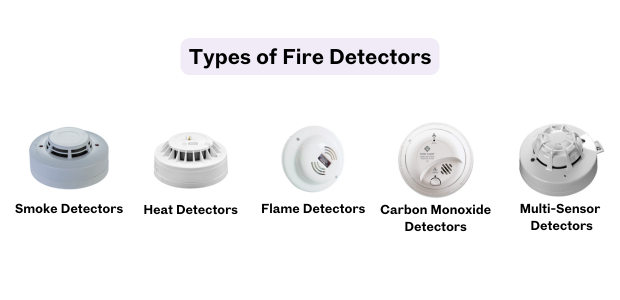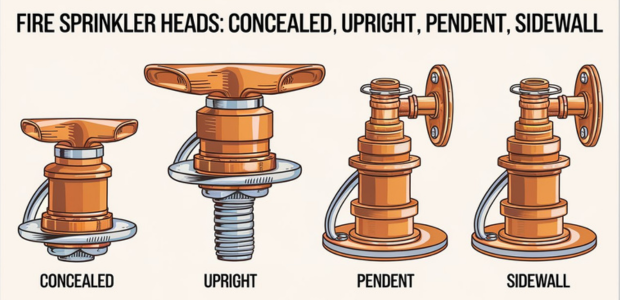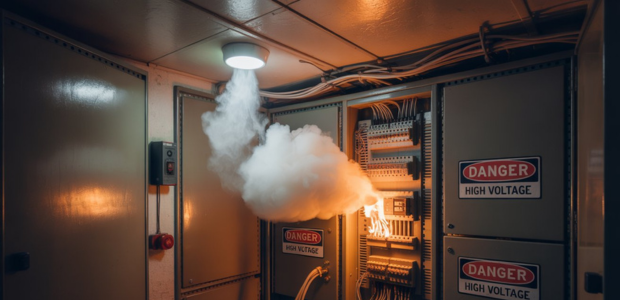- January 31, 2025
- Interface Digital
Fire safety is an important part of preserving both life and property. One of the most essential tools in fire safety systems is the fire detector.
Whether in homes, offices, or industrial spaces, fire detectors serve as the first line of defense, alerting people to the presence of a potential fire before it escalates.
But did you know there are various types of fire detectors, each designed to detect specific fire characteristics? In this blog, we’ll break down the different types of fire detectors to help you make an informed choice.
Importance of Fire Detectors in Fire Safety Systems
Fire detectors play a vital role in preventing catastrophic losses caused by fires. They work by identifying early signs of fire, such as smoke, heat, or gas, and triggering alarms to alert occupants.
When integrated into modern fire safety systems, fire detectors can also send real-time notifications to monitoring centers or emergency services, ensuring a swift response.
Without these devices, fire incidents could go unnoticed until it’s too late.
Types of Fire Detectors
Fire detectors come in various forms, each catering to different fire detection needs. Let’s explore these types of smoke detectors and how they work:
1. Smoke Detectors
Smoke detectors are the most common fire detection devices and are highly effective in identifying fires at their early stages. Below we have mentioned smoke detector types:
Ionization Smoke Detectors:
These detectors are designed to sense invisible smoke particles created by fast-burning fires, such as those involving paper or flammable liquids.
They use a small amount of radioactive material to create an electric current, which gets disrupted when smoke particles enter the device.
Photoelectric Smoke Detectors:
These detectors are ideal for detecting smoldering fires, such as those caused by burning furniture or electrical wiring. They use a light beam and sensor to detect smoke particles that scatter the light.
Dual-Sensor Smoke Detectors:
A combination of ionization and photoelectric technologies, dual-sensor smoke detectors offer enhanced safety by covering both fast-burning and smoldering fires.
2. Heat Detectors
Heat detectors are triggered by a rise in temperature or when the temperature crosses a predefined threshold.
Smart home security systems with features to mitigate false alarms, such as intelligent detection, are better suited for areas prone to false alarms.
While they don’t provide early warnings like smoke detectors, heat detector types such as fixed temperature detect fire in high-heat environments.
3. Flame Detectors
Flame detectors are designed to identify the presence of flames directly and are commonly used in industrial or outdoor settings.
Infrared (IR) Flame Detectors:
These detectors sense infrared radiation emitted by flames. IR detectors are effective in detecting flames from a distance and are less prone to false alarms caused by dust or smoke.
Ultraviolet (UV) Flame Detectors:
UV detectors identify flames by detecting ultraviolet radiation. They are highly sensitive and offer rapid response times but can sometimes be affected by false triggers like welding or sunlight.
Combination UV/IR Flame Detectors:
By combining ultraviolet and infrared technologies, these detectors reduce false alarms and provide a more reliable flame detection solution, making them ideal for high-risk environments.
4. Carbon Monoxide (CO) Detectors
Carbon monoxide detectors are crucial for identifying fires that produce colorless, odorless CO gas. They are particularly useful in detecting smoldering fires that might not produce significant smoke.
Additionally, CO detectors also protect against poisoning caused by gas leaks.
5. Multi-Sensor Detectors
Multi-sensor detectors use a combination of smoke, heat, and gas detection technologies to provide comprehensive fire detection.
These advanced devices are suitable for environments with varying fire risks, as they can adjust sensitivity based on detected conditions.
Key Features to Consider When Choosing Fire Detectors
1. Sensitivity to Fire Types
Different detectors respond to different fire characteristics. Choose a detector that matches the fire risks specific to your environment.
2. Placement Requirements
Evaluate the area before installing smoke detectors. For example, smoke detectors are ideal for living spaces, while heat detectors work well in kitchens.
3. Maintenance and Durability
Look for flame detection systems that are easy to maintain and durable enough to withstand the conditions of the fire alarm system installation's environment.
4. Integration with Fire Safety Systems
Opt for detectors that can seamlessly integrate with alarm systems, sprinklers, or emergency notification systems for enhanced protection.
How to Choose the Best Fire Detectors for Your Needs
1. Assess the Environment
Evaluate the specific fire risks and equip fire safety equipment for buildings.
For instance, industrial spaces might require flame detectors, while residential spaces benefit more from smoke and carbon monoxide sensors.
2. Consider Building Size and Layout
Larger buildings may need a combination of detectors to ensure comprehensive coverage, while smaller spaces can use compact, multi-functional devices.
3. Opt for Advanced Technology
Choose fire alarm panels with advanced features such as Wi-Fi connectivity, self-testing, or AI analytics for improved functionality and reliability.
4. Work with Certified Professionals
Consult fire safety experts to design and look for fire detector installation services as per your building’s needs. Professionals ensure compliance with safety regulations and optimal detector placement.
Conclusion
Understanding the different types of fire detectors is crucial in creating a robust fire safety system.
From smoke and heat detectors to flame and CO detectors, each type has unique features suited for specific environments.
By carefully assessing your needs and considering factors like sensitivity, placement, and integration, you can select the best fire detectors to ensure maximum safety.
Remember, fire safety is not just a necessity—it’s a responsibility. Protect your space and the people within it by investing in the right fire detection system.









